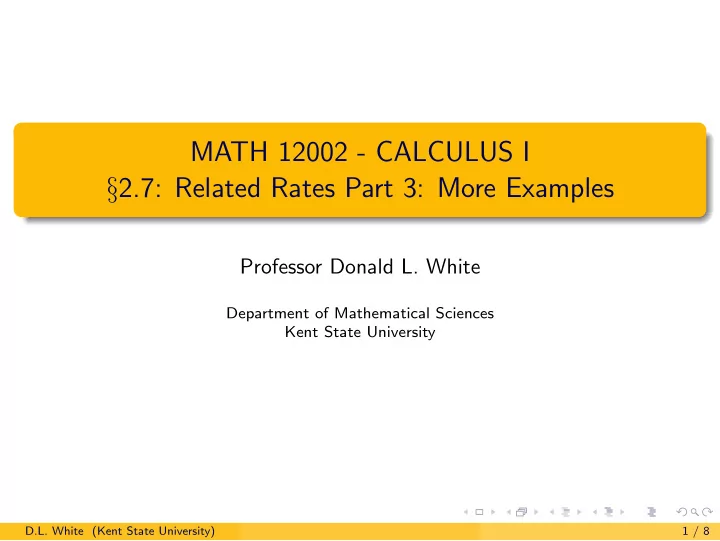

MATH 12002 - CALCULUS I § 2.7: Related Rates Part 3: More Examples Professor Donald L. White Department of Mathematical Sciences Kent State University D.L. White (Kent State University) 1 / 8
Examples Example 1 At noon, ship A is 100 km west of ship B. Ship A is sailing south at 35 kilometers per hour (km/h) and ship B is sailing north at 25 km/h. How fast is the distance between the ships changing at 4 pm? Solution Let A = distance from starting point to ship A, B = distance from starting point to ship B, Z = distance between the ships. Given: dA dt = 35 km/h and dB dt = 25 km/h. Want: dZ dt at 4 pm. We need to relate A, B, and Z and then take derivatives with respect to time in order to relate dA dt , dB dt , and dZ dt . [Continued → ] D.L. White (Kent State University) 2 / 8
Examples Example 1 Solution [continued] We have the following situation at a given time after noon: q SHIP B ✪ ✻ ✪ ✪ ✪ B ✻ ✪ ✪ 100 km ✪ A + B ✪ Z ✪ ✪ ❄ A ✪ ✪ ✪ ✪ ❄ 100 km SHIP A q By the Pythagorean Theorem, 100 2 + ( A + B ) 2 = Z 2 . [Continued → ] D.L. White (Kent State University) 3 / 8
Examples Example 1 Solution [continued] We now have Z 2 = 100 2 + ( A + B ) 2 , and taking derivatives with respect to time yields � dA � 2 Z · dZ dt + dB dt = 2( A + B ) . dt Hence dZ dt = A + B � dA dt + dB � . Z dt Finally, at 4 pm, A = (35)(4) = 140 km, B = (25)(4) = 100 km, and � 100 2 + (140 + 100) 2 = � 100 2 + 240 2 = 260 km , Z = and so dZ dt = 140 + 100 (35 + 25) = 720 13 ≈ 55 . 4 km/h. 260 D.L. White (Kent State University) 4 / 8
Examples Example 2 A plane flying with a constant speed of 210 miles per hour passes over a ground radar station at an altitude of 2 miles and climbs at an angle of 45 ◦ . How fast is the distance from the plane to the radar station increasing 2 minutes later? Solution Let p = distance of plane from the point where it passed over the station, z = distance from the plane to the station. Given: dp dt = 210 mph. Want: dz dt after 2 minutes. We need to relate p and z and then take derivatives with respect to time in order to relate dp dt and dz dt . [Continued → ] D.L. White (Kent State University) 5 / 8
Examples Example 2 Solution [continued] We have the following situation at a given time: r PLANE � ✁ ✁ � p ✁ � ✒ ✁ � z ✁ 135 ◦ ✁ 2 mi ✁ ✁ RADAR r We use the Law of Cosines to relate p and z, and this says 2 2 + p 2 − 2(2)( p ) cos 135 ◦ z 2 = √ 4 + p 2 − 4 p · ( − = 2 / 2) √ 4 + p 2 + 2 = 2 p . [Continued → ] D.L. White (Kent State University) 6 / 8
Examples Example 2 Solution [continued] √ We have z 2 = p 2 + 2 2 p + 4 , and taking derivatives with respect to time, we obtain √ 2 z dz dt = 2 pdp 2 dp dt + 2 dt , and so √ 2 p dp 2 dp dt + 2 dz dt = dt 2 z √ p + 2 · dp = dt . z We know dp dt = 210 mph, and so we now need to determine the values of p and z two minutes after the plane passes over the station. [Continued → ] D.L. White (Kent State University) 7 / 8
Examples Example 2 Solution [continued] 1 Since the plane is flying at a speed of 210 mph, 2 minutes (or 30 hour) after it passes over the station, p = 210 · 1 30 = 7 miles , and √ √ � � 7 2 + 2 z = 2(7) + 4 = 53 + 14 2 miles . Therefore, √ dz 7 + 2 dt = · 210 ≈ 207 mph. √ � 53 + 14 2 D.L. White (Kent State University) 8 / 8
Recommend
More recommend